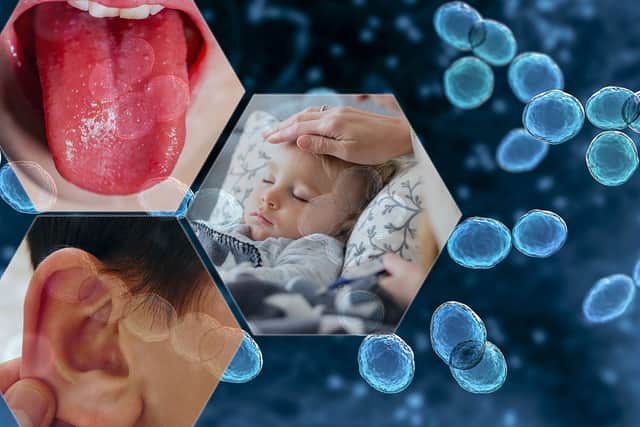North West has highest rate of scarlet fever and Alder Hey Children’s Hospital shares signs of Strep A
and live on Freeview channel 276
The North West has the highest scarlet fever rates in England, figures from the UK Health Security Agency (UKHSA) show.
Scarlet fever is caused by the same bacteria that can lead to invasive Group A strep (iGAS), which has claimed the lives of nine children in the UK.
Advertisement
Hide AdAdvertisement
Hide AdA five year-old girl in Northern Ireland was confirmed as the ninth child to die from illness linked to Strep A infection. Seven children in England and one child in Wales have also died.
The condition iGAS is caused by a bacteria called group A streptococci, which usually causes mild illnesses such as strep throat and scarlet fever. On very rare occasions, the bacteria can get into the bloodstream and cause iGAS.
The North West has the highest rates of scarlet fever, at 13 cases per 100,000 residents in the latest 10-week period recorded, with 957 cases in total. The region also has an iGAS rate above the national average.
Alder Hey advice
A spokesperson for Alder Hey Children’s Hospital said: “There is much more GAS around this winter than in recent years, causing a lot of children to be unwell. We think this is because there is much more mixing now and these bugs are new to many young children, so they are more likely to catch and spread them.
Advertisement
Hide AdAdvertisement
Hide Ad“GAS usually causes a mild illness with fever and a sore throat (Strep throat) but not a runny nose or too much of a cough. Your child may be poorly for a few days but will usually recover. Antibiotics may help them recover quicker.”
Signs that suggest your child might have Strep throat are:
- Fever within the last 24 hours
- White spots at the back of their throat (pus on their tonsils)
- Very large or red tonsils
- Sore (tender) lumps under their chin
- If they have become poorly quickly over the past couple of days
- No cough or runny nose
Signs of Scarlet Fever:
- Sore throat
- Headache
- Fever
- Nausea
- A fine, pinkish or red body rash with a tiny, rough pimples (“sandpapery” feel) - on darker skin the rash can be more difficult to see but the skin will have a sandpapery feel
- Very red tongue or lips
Contact NHS 111 or your GP if you are worried your child has Scarlet Fever, because early treatment of with antibiotics is important to reduce the risk of complications such as pneumonia or a bloodstream infection. It is highly infectious so keep your child at home until at least 24 hours after beginning antibiotics.
Strep A facts and figures
Rates of iGAS strep are now four times higher than usual among children aged one to four, official figures for England show.
Yorkshire and the Humber has England’s highest rates of iGAS, with 1.4 cases per 100,000 residents in the most recent 10-week period. The North East, North West and South East also have rates above the England average.
Advertisement
Hide AdAdvertisement
Hide AdDr Colin Brown, deputy director of the UKHSA, said: “We are seeing a higher number of cases of Group A strep this year than usual. The bacteria usually causes a mild infection producing sore throats or scarlet fever that can be easily treated with antibiotics. In very rare circumstances, this bacteria can get into the bloodstream and cause serious illness – called invasive Group A strep.


“This is still uncommon; however, it is important that parents are on the lookout for symptoms and see a doctor as quickly as possible so that their child can be treated and we can stop the infection becoming serious. Make sure you talk to a health professional if your child is showing signs of deteriorating after a bout of scarlet fever, a sore throat, or a respiratory infection.”
Across England, infection rates have risen most dramatically among children aged one to four, with 2.3 cases per 100,000 - four times higher than the average rates in the three years to March 2020, before the coronavirus pandemic. And infection rates among children aged five to nine have tripled compared to this three-year average.
Health officials are investigating the rise but say there is currently no evidence that a new strain is circulating.
Advertisement
Hide AdAdvertisement
Hide AdRates of scarlet fever, which is caused by the same bacteria, are also about four times higher than average. The North West has the highest rates of scarlet fever, at 13 cases per 100,000 residents in the latest 10-week period, with 957 cases recorded in total.
Parents are advised to call 999 or go to A&E if their child is having difficulty breathing, there are pauses when their child breathes, the skin, tongue or lips are blue or the child is floppy and will not wake up or stay awake.